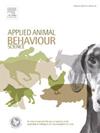Attendance patterns of provisioned Australian humpback dolphins (Sousa sahulensis) in Tin Can Bay, Australia – Further indication of male bonding and alliance
IF 2.2
2区 农林科学
Q1 AGRICULTURE, DAIRY & ANIMAL SCIENCE
引用次数: 0
Abstract
Tin Can Bay, Queensland, is one of four free-ranging dolphin feed provisioning sites in Australia and the only one featuring Australian humpback dolphins (Sousa sahulensis). The site attracts the same 5–10 dolphins a year, most of which return regularly, and some which have been in attendance since the 1990s. Historical records were obtained for the period March 2010 to March 2021 covering dolphin attendance to the provisioning station including dolphin name, arrival time, and departure time. Tourist numbers were also obtained which included the total number and how many of that total directly took part in provisioning. Attendance of dolphins to the provisioning site has increased over the years both in frequency and total numbers. There was evidence of group cohesion between four particular dolphins (one mother-offspring pair and one male pair). The strongest pairing was seen between two males, indicating bond formation in adult male humpback dolphins, which may be indicative of an alliance. Specific events were also looked at in detail including cyclones, flooding COVID-19 restrictions, which reduced dolphin and/or human attendance.
澳大利亚锡罐湾被供养的澳大利亚中华白海豚(Sousa sahulensis)的出勤模式--雄性结合和联盟的进一步迹象
昆士兰锡罐湾是澳大利亚四个自由放养海豚饲料供应点之一,也是唯一一个以澳大利亚座头海豚(Sousa sahulensis)为主题的供应点。该地点每年吸引同样的 5-10 条海豚,其中大多数定期返回,有些自 20 世纪 90 年代以来一直在此活动。我们获得了 2010 年 3 月至 2021 年 3 月期间海豚前往补给站的历史记录,包括海豚名称、抵达时间和离开时间。此外,还获得了游客人数,包括总人数以及其中有多少人直接参与了补给。这些年来,海豚前往补给站的频率和总人数都有所增加。有证据表明,四条特定的海豚(一对母子和一对雄性)之间存在群体凝聚力。最强的配对出现在两头雄性海豚之间,这表明成年雄性中华白海豚之间形成了纽带关系,这可能是结盟的迹象。我们还详细研究了具体事件,包括气旋、洪水、COVID-19 限制,这些都减少了海豚和/或人类的参与。
本文章由计算机程序翻译,如有差异,请以英文原文为准。
求助全文
约1分钟内获得全文
求助全文
来源期刊

Applied Animal Behaviour Science
农林科学-行为科学
CiteScore
4.40
自引率
21.70%
发文量
191
审稿时长
18.1 weeks
期刊介绍:
This journal publishes relevant information on the behaviour of domesticated and utilized animals.
Topics covered include:
-Behaviour of farm, zoo and laboratory animals in relation to animal management and welfare
-Behaviour of companion animals in relation to behavioural problems, for example, in relation to the training of dogs for different purposes, in relation to behavioural problems
-Studies of the behaviour of wild animals when these studies are relevant from an applied perspective, for example in relation to wildlife management, pest management or nature conservation
-Methodological studies within relevant fields
The principal subjects are farm, companion and laboratory animals, including, of course, poultry. The journal also deals with the following animal subjects:
-Those involved in any farming system, e.g. deer, rabbits and fur-bearing animals
-Those in ANY form of confinement, e.g. zoos, safari parks and other forms of display
-Feral animals, and any animal species which impinge on farming operations, e.g. as causes of loss or damage
-Species used for hunting, recreation etc. may also be considered as acceptable subjects in some instances
-Laboratory animals, if the material relates to their behavioural requirements
 求助内容:
求助内容: 应助结果提醒方式:
应助结果提醒方式:


